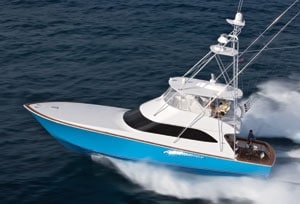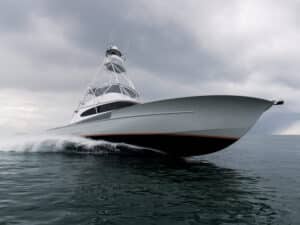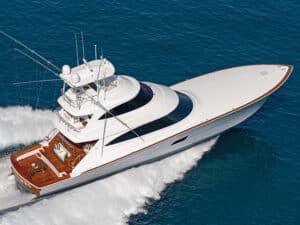
02br_viking
Precious few boatbuilders lay claim to the kind of success enjoyed by Viking since the Healey brothers purchased the company from Petersen-Viking Yachts back in 1964. They reached a high level of success by consistently making significant improvements to each successive design, rather than simply filling size gaps in their lineup. True to this tradition, the company’s new 60-foot convertible incorporates all of the proven Viking innovations, while moving forward to set new benchmarks in performance and style.
Performance
The Viking 60 cruises very comfortably at almost 36 knots, with a top-end of at least 40 with the optional CAT C32 ACERTs rated at 1,825 hp each. Standard power of dual MAN 1,550 hp V-12s will be somewhat less – around 37 knots.
Borrowing a page from the megayacht playbook, Viking now allows you to transfer fuel from one tank to the other from the flybridge helm station. Not only a convenience for long ocean crossings, shifting fuel from the aft tank forward allows you to make up about five inches of draft – a real boon in some shallow-water slips in the Keys, Bahamas and elsewhere.
One thing Viking now does on every new boat is fine-tune the props quickly and inexpensively to optimize performance. Historically, getting the right prop for a boat involved equal parts science and voodoo. Builders just kept changing props until the right rpms and loads were reached. It often took weeks.
Now, thanks to a company called Veem Propellers, anyone can adjust the pitch of their props by sliding in a composite strip along the prop’s edge, without having to haul out. This also works terrifically for those who take their boats on long cruises – like down to the islands or over to Mexico. You can adjust your prop for all the added weight you have to carry on the crossing and then readjust for optimum fishing performance.
Flybridge
This 60-footer offers an incredible amount of storage space (overt and covert) on the bridge. And once again, I’m always impressed by Viking’s attention to detail, even in spaces you might not normally see. For example, look at the bottoms of all the storage spaces and you’ll see the surface is scalloped rather than flat. This allows air to circulate under your stored items, retarding the growth of mold and mildew in those airtight compartments. You could hardly ask for better visibility from the helm with half the cockpit and two-thirds of the foredeck in view at all times.
Engine Room
Engines mount low in the compartment with the stringers rising to about knee height. Viking arranges considerable crawl space outboard of the diesels and situates the air-conditioning compressors, generators and Eskimo icemaker on the aft bulkhead. Separate pump rooms forward hold the quieter machinery.
I’m grateful that Viking installs crash-pump valves on the forward ends of the engines, although I’d prefer to see them a bit closer to the entry hatch. A ventilation system designed by Delta T also functions as part of the fire-suppression system, closing the louvers when the extinguishing system goes off to help smother any flames.
Hinged hatches hide all the pumps, creating a much a cleaner look. In fact, I’d say this represents the cleanest-looking engine compartment Viking has ever created. And speaking of clean, an oil-transfer system lets you pump oil into (or out of) containers in the cockpit or even up on the dock. I also appreciated the molded-in transducer block that keeps the huge transducer flush with the bottom of the boat, eliminating the need for turbulence-producing fairing blocks. This configuration let us maintain bottom-lock at every speed.
Interior
Historically, Viking has offered only one interior finish – high gloss. Sure, it looks great, but it also creates a never-ending job of wiping off fingerprints. For the first time in my memory, Viking now offers a satin-finish varnish as an option.
This 60 comes in either a three- or four-stateroom configuration. The standard forepeak cabin layout consists of a queen-size island berth on centerline with copious storage beneath. Our test boat sported the optional oblique berths – an upper single to port and an oversized twin to starboard. Both layouts afford lots of storage space and amazing headroom. The starboard side also holds a “sunken” cabin with your choice of fore-and-aft twins or an upper single and an oversized twin. Both the forward master and guest staterooms come with their own head with shower. The aft head doubles as a day head.
All the layouts call for the master cabin to port with an oblique queen berth – head aft and you’ll find a large hanging locker and another private head with shower. The atypical salon layout places the dinette to starboard, a big galley opposite with an island, cabinetry along the port salon bulkhead and an L-shaped settee starboard. Piston hinges raise the seat on the settee to reveal ample rod storage.
Interestingly, moving the settee and dinette to the same side of the boat makes the space seem much more open.
Cockpit
As you’d expect, this 60 sports a mezzanine in the cockpit – perfect for watching the baits in high style and comfort. However, I did find it a bit of a chore to access the engine compartment through the mezzanine since you need to lift the seat back and remove the seat cushion before lifting the hatch.
A refrigerated box does away with any on-deck portable coolers. You can carry a day’s worth of rigged baits in several layers. I never understood spending millions on a fancy boat and still needing an ugly cooler sliding around the cockpit.
Customers dictate the cockpit layout, and chose the placement and position of livewells, fish boxes, refrigerators, freezers, barbecue grills and so on. And you’ll find plenty of room for all of it – this cockpit can accommodate a game of half-court basketball.
Viking really excels at the effective use of what could be considered dead space on most boats. In places that you can’t even access on many boats (such as under side walkways), Viking provides stowage for gaffs, mops, wet chamoises and other cockpit necessities.
Design and Construction
One of Viking’s greatest innovations comes in the electrical systems aboard this 60. Viking uses the Moritz Octoplex Multiplexed Power Management and Monitoring System. This system provides the operator complete visibility and control of the vessel’s entire electrical system from any control screen. It also allows you to remotely monitor alarm functions including battery, engine and generator data; fuel transfer; and even electronic instrumentation such as depth sounders, GPS units and electronic compasses. The system cuts out 1,000 pounds in wiring and panels, replacing it all with simple LCD touch-screen displays. Bottom line: The captain can control every onboard electrical system right from the helm or from anywhere else you mount a screen.
Viking builds the 60 using biaxial and triaxial knitted fiberglass with vacuum-bagged, high-density end-grain balsa in the bottom and lower-density balsa laminated into the hull sides, decks and superstructure. All of the bulkheads and stringers contain PVC foam coring.
If you get a chance, take a look at the new 60 alongside an older 61. You’ll immediately see a dramatic increase in the sleekness of the 60 with its radius curves and low-slung bow. As I said, with every new model, Viking ups the ante in design, construction and innovation – a simple explanation for why the company remains one of the most popular and successful builders today.
LOA……60’8″
**BEAM……18’9″
DRAFT……5’1″**
WEIGHT……73,000 pounds
**FUEL……1,620 gallons
WATER……300 gallons
POWER……T 1,550 hp MAN V-12s
BASE PRICE……$2,241,000**
Viking Yacht Company / New Gretna, New Jersey / 609-296-6000 / www.vikingyachts.com







